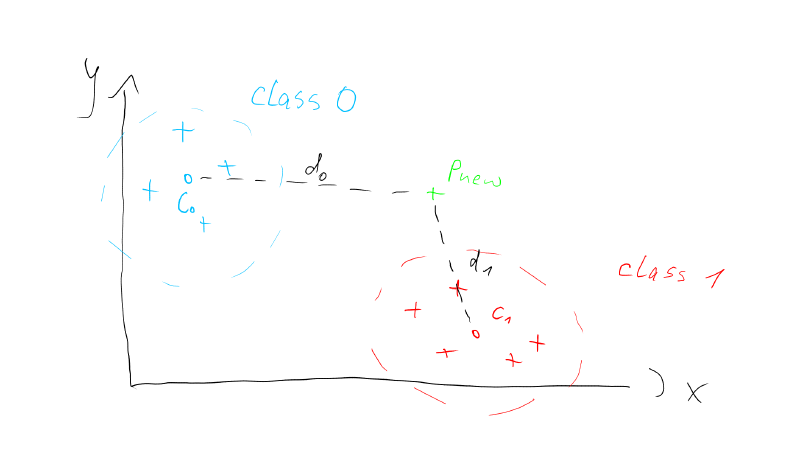IFD:EAI SoS21/course material/Session 4: Programming the Classifier Part1: Difference between revisions
| Line 7: | Line 7: | ||
=Description of Classifier Code from Session 4= | =Description of Classifier Code from Session 4= | ||
Until now, we have been looking at points on a 2D plane. We know how to calculate the distance between them and how to find the centroid of a point cloud. Let's call these point | Until now, we have been looking at points on a 2D plane. We know how to calculate the distance between them and how to find the centroid of a point cloud. Let's call these point clouds classes from now on. With this tool set at hand, we can already code a simple classifier. We could e.g. detect whether any given point (P_new) is closer to the point cloud which we call class_0 or class_1. We can find out, by calculating the distances of P_new to the centroids of the classes c_0 abd c_1 as shown in the picture below. | ||
[[File:2d_classify.png|800px]] | [[File:2d_classify.png|800px]] | ||
Revision as of 19:37, 5 May 2021
Solutions to Homework Task 2
Spoiler Alert! Again, accept the challenge and try on your own first! :)
Description of Classifier Code from Session 4
Until now, we have been looking at points on a 2D plane. We know how to calculate the distance between them and how to find the centroid of a point cloud. Let's call these point clouds classes from now on. With this tool set at hand, we can already code a simple classifier. We could e.g. detect whether any given point (P_new) is closer to the point cloud which we call class_0 or class_1. We can find out, by calculating the distances of P_new to the centroids of the classes c_0 abd c_1 as shown in the picture below.
Homework
This week your task will be to modify the code from monday's session to work on n-dimensional data points. "N-dimensional" means the number of dimension can be chosen when we instantiate the clusterer. So the same code should work for 2 dimension (as we programmed it already), 3 dimension, 4 dimensions and so on...
Feel free to fork the repl.it and include a new class "PointND":
The Class PointND should should be structured as shown in the following header file:
#ifndef PointN_H
#define PointN_H
#include <vector>
using namespace std;
class PointND {
public:
PointND(int dimensions); // constructor for zero point of n-dimensions
PointND(vector<float> newND); // constructor for a point which copies the coordinates from an n-dimensional vector
PointND operator+(PointND& p2);
PointND operator/(float f);
float getDim(int idx_dimension); // get the component of the indexed dimension, (this was getX() and getY() before)
int size() // return how many dimension our current point has!
{
return _pointND.size();
}
void print();
float getDistance(PointND&); // extend the euclidean distance to n dimensions
private:
vector<float> _pointND;
};
#endifYour task is to:
- Implement a PointND.cpp file that behaves like our class Point2D on n-dimensional points
- Test that class with a 3D distance measurement, and on success
- Modify our clusterer to work with the new PointND class!
Have fun and if you're stuck, write a mail or post a message in the forum!
Best wishes, Clemens
